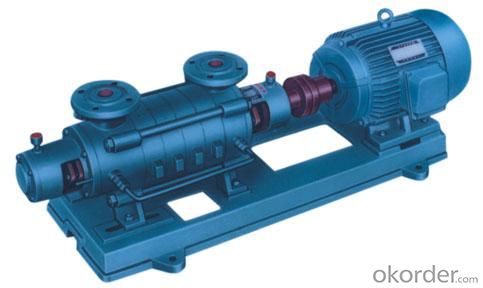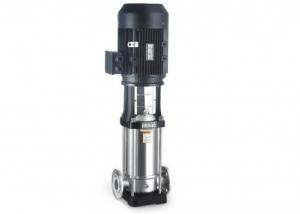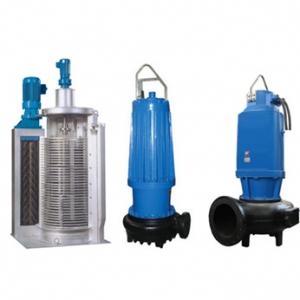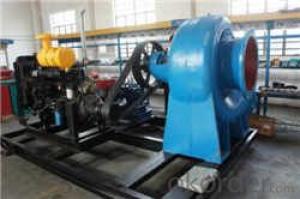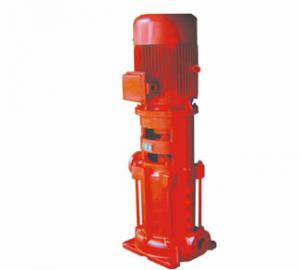Multistage Single Suction Centrifugal Pump DG Series
- Loading Port:
- China Main Port
- Payment Terms:
- TT OR LC
- Min Order Qty:
- -
- Supply Capability:
- -
OKorder Service Pledge
OKorder Financial Service
You Might Also Like
General Description
DG horizontal Multi-stage boiler feed pump can delivery clear water without solid particles or other liquid which the physical and chemical feature is similar with clear water. It is suitable for boiler feed water or deed water for high pressure boiler. The temperature range of the liquid is from -20℃ to150℃, and the inlet pressure is not allowed more than 0.6Mpa.
Performance range
Capacity : 3.75~ 288m3/h
Head : 50 ~ 1540m
Instruction of pump type
For Example DG25-80X10
DG — Single-suction, multi-stage, boiler feed pump.
25 — Pump capacity 25 m3/h.
80 —Single-stage head of pump 80m .
10 — pump stage number is 10.
Structure
DG series pump is single casing segmental multi-stage centrifugal pump, the main parts is stator, rotor, bearing and shaft.
Stator part: it mainly consists of suction stage, mid-stage, discharge stage and diffuser; they are strained through a lever and form a working chamber. The inlet and the outlet are vertical upward. The combined surface between each stage is sealed through metal surface and also with sealing o-ring as auxiliary seal.
Rotor part: it mainly consists of shaft, impeller, and balance drum and shaft sleeve. Shaft transfers power to impeller and make it work. The axial force is balanced by balance disc and there is rechargeable shaft sleeve to protect shaft.
Bearing part: It mainly consists of bearing body, shaft cover and sliding bearing. There are two single centripetal ball bearings in bearing body to prevent balance disk from abrasion. The sliding bearing is lubricated by dilute oil, there is cooling chamber in bearing body and the bearing can be cooled with exterior water.
Shaft seal part: shaft seal uses soft packing seal. It mainly consists of seal box, packing, packing ring and packing cover. The shaft is sealed, cooled and lubricated by exterior water from seal chamber. The mechanical seal can also be used as requirement and it need be cooled, lubricated and washed by exterior water.
Drive: Pump is directly driven by motor through flexible coupling. View from motor end, the rotating direction of pump is clockwise.
Material of main parts
The medium-contacting parts are made of cast iron .
- Q: Where can I find a really good deal online for Spectre 4480 Water Pump Pulley Shim Kit
- You can purchase the Spectre 4480 Water Pump Pulley Shim Kit from OKorder for the heavily discounted price of $1.02. That's a full 83% or $4.97 off the list sticker price for this item. The product features: * Provides proper drive belt alignment with water pump * Fixed between the water pump pulley and drive flange * Shims pulley out 1/16, 1/8, or 3/16 for proper alignment * 3 shims per kit If you're interested in taking advantage of this great offer, visit the link below.
- Q: Domestic pump automatic shut off the water, but also turn around, stop what happened?
- You can find a water pump factory people ask, ah, Baidu, find a corporate website, many have online advice. By the way, a site called water industry navigation, pump manufacturers included a lot, and find it may be faster.
- Q: I have a 1997 Pontiac Grand Prix 3.8 v6 engine. My car has been overheating lately and my low coolant light came on so i put antifreeze in it and the light went off. I drove about 3 blocks and the low coolant light came back on again and the thermostat was at the hot mark so i checked the antifreeze and it was just about empty. I did noticed when I was pouring the antifreeze that some did run out the bottom of the car but it wasn't alot. Also I noticed that in the morning when I get up and drive my car the thermostat could be at cold but if I drive about 3 blocks it's almost at the hot mark. Please help me determine whats wrong with my car. Is my water pump bad?
- You okorder has a forum where you can search and find out a lot about problems on this type of vehicle.
- Q: Our mechanic wants to replace my husband's water pump in his 1996 Saturn saying it is quite loose. We'd like to wait until next week since its a 2 day job and with our schedules it would be difficult. Can it wait for a couple of weeks? Could this leave him stranded?
- A leaking water pump could be caused by a bad gasket so it does not have to be changed. Changing a gasket is cheaper. If the leak is due to a crack or a pinhole, then by all means have it changed otherwise you risk a crack of the cylinder head caused by overheating which can cost your thousands. You can get a reconditioned or 2nd hand water pump and can save you money. Just ask your Napa store. Typically, second hands are 20% cheaper and can last for years. Good luck.
- Q: I have a 1995 Jeep Grand Cherokee 6 cyl while driving home the other day my check engine light came on ,then I noticed my battery was loosing its' charge ,then I noticed my temperature gauge rising very fast.I stoped to see what the problem was.The vehicle had over heated and the serpentine belt was partially off Iet it cool down then I put water in it and drove it home which was about a quarter of a mile.I noticed no problems with the fan hitting the water pump pully until I put the belt back on .My water pump pulley appears to be off line how do I fix this?
- your water pump bearing is probably worn out, unfortunately if this is the case replacing the water pump is the only option take the belt off again grab the fan if you can wiggle it forward and back its no good if its ok go to the belt tensioner, Its the next most likely culprit if it get out of line it will throw the whole thing out of whack good luck
- Q: One mechanic told me that my Toyota Corolla 2004 CE's water pump is leaking and I need to change pump and its belt costing me around $450. I took it to other mechanic today and he told that water pump looks good and no need to worry. I need to know how I can verify that water pump is leaking or not. Below are some facts of the car that I noticed myself.1. The engine collant level is above half level about at 70% 2. I started my car around 8.30 PM @ 90 degree F after break of 3 hours and the temprature gauge reach to half in 5 minutes.Please advice what can be done to determine the leak is there or not else I have to take it to other mechanic.
- Toyota Corolla Water Pump
- Q: How hard is putting in a water pump for my 5-series on a 1-10 scale ?and how do i put it in ? details please !? i dont have a chitlon for it . ive worked a lot on this car and i do know some things about it, but not very car savy. Thank you !!
- wow, first of all the car is pretty old, becareful. u may need new clips for hoses and gaskets. from 1-10 ill say 7.
- Q: This is a brand new water pump and we used plenty of gasket maker. Does this year of f150 need the back plate that comes on the water pump?
- if its leaking from the weep hole then u have a bad pump.....return it and get another.... if its leaking from a seal or from the silicone ....u will need to remove it and reinstall it......this time make sure silicone is evenly spread ......
- Q: How much solar energy would you need to generate and run a small water pump? Say one that is big enough to extract water from a bucket that is 1 ft wide x 2 ft deep? What size solar panel would you need to accomplish this?
- Assuming you are only interested in pumping the water out of the back (and onto the floor). The majority of the energy will be consumed trying to get the water to the tip of the bucket (where it will then fall to the floor), so it will initially require very little energy, but by the time it's trying to remove the last bit of water it will have to lift it 2' high(and water exerts 2.41psi per sq. so it need to exert 2.82 PSI+force exerted by the 2' of tubing/pipe). It would also depend on how quickly you want to get the water out of the bucket.
- Q: House has bad mains pressure, so previous owner installed a quot;Holding Tankwhich stores water from the mains, before pumping it into the house for the internal tanks.However, after some recent plumbing work when the mains was turned off, it's running a little weird. The pump seems to be constantly running, although at a very low level, and some times when the taps/fawcets are opened, they seems to be nothing for up to 30 seconds (only air), and then the water rushes out. Same thing for toilet/WC cisterns..Any advice/pointers appreciated.CheersJM
- If the possibility exists then relocating the pump below the level of the water source prevent air entering the pump. Having leaks in pipes and seals will let in air all the time and should be corrected. Many centrifugal pumps have a priming hole that is on top to fill the pump with water if they are not self priming but you need to make sure that the pump does not drain empty while closing the hole and starting the pump. Some pumps have a priming tank that is filled with water and then the opened to the priming port, these can be used with the pump already running and will collect the air bubles from the pump while it is starting. Positive displacement and self priming pumps create sufficient suction/vacuume to draw the colum of water intot the pump to get going and if these fail it is due to excess height above the suction water level or leaks in pipes or seals.
Send your message to us
Multistage Single Suction Centrifugal Pump DG Series
- Loading Port:
- China Main Port
- Payment Terms:
- TT OR LC
- Min Order Qty:
- -
- Supply Capability:
- -
OKorder Service Pledge
OKorder Financial Service
Similar products
Hot products
Hot Searches
Related keywords

